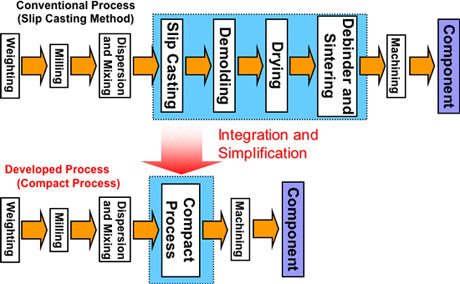| Posted: November 21, 2007 |
Successful integration and simplification of ceramic manufacturing process by using microwave |
|
(Nanowerk News) In recent times, humans have faced the threats of global warming and depletion of energy resources. In Japan, about 40% of the greenhouse gases generated due to energy consumption are emitted from the industrial sector. In particular, the ceramic industry adversely affects the environment. Its energy consumption per product is high because it requires long periods of heating at high temperatures during manufacturing and because it emits many greenhouse gases such as carbon dioxide during the manufacturing process.
|
|
With the rapid development in fields such as nanotechnology, electronics, and telecommunications, today's ceramic industry aims to develop high value-added products featured by high performance and new functions. Thus, it is necessary to fundamentally review the manufacturing process for next-generation ceramics. From the viewpoint of these social requirements, it is strongly desired to develop a highly efficient manufacturing process technology that reduces the time per process, reduces the energy consumption, and minimizes the number of processes.
|
|
Now, researchers in the Advanced Sintering Technology Group at the Advanced Manufacturing Research Institute of the National Institute of Advanced Industrial Science and Technology (AIST) in Japan have developed a new process that integrates and simplifies the ceramic manufacturing process by using microwave technology. This new process reducing the manufacturing periods of ceramics to less than half, and it is a low environment load manufacturing process it reduces the energy consumption in manufacturing.
|
 |
| Concept of the developed process (Image: AIST)
|
|
Newly developed collapse-type molding die has enabled the omission of the demolding and debinder processes. In this new process, a series of heating processes from drying to sintering are carried out inside a microwave furnace after ceramic slurry is poured into the collapse-type mold.
|
|
The slip casting method is one of the representative forming methods of ceramic, and it is used for complex-shaped products and large products such as sanitary ware. It comprises two methods of forming. The first method is drain casting, which pours low-concentrate slurry into a water-absorbing porous mold such as gypsum mold, molds a casting layer on the mold wall, and subsequently drains the slurry. The second method is the solid casting method, which pours concentrated slurry into a mold and solidifies it. In both methods, ceramic is dried after its release from the mold, and the compact is dewaxed and sintered inside the baking furnace. Subsequently, it undergoes machining to obtain a final product.
|
|
Although both methods are highly versatile, long periods are required to dry the compact. At the same time, it is indispensable to add an organic binder to build a compact of complicated shape, however, the debinder process by heating requires several tens to several hundreds of hours. Therefore, it is necessary to review the process from the viewpoint of reducing the energy consumption and improving the productivity. Scratches in the molded product made during removal from the mold and the defects generated during the drying and debinder processes are also problems.
|
|
The AIST scientists have developed a compact process that integrates the casting (forming), demolding, drying, and debinder and sintering processes into one process. This process is a low environment load manufacturing process that simplifies the process, reduces the manufacturing periods, and reduces the energy consumption by carrying out a series of heating processes from drying to sintering inside the microwave heating furnace without demolding after the slurry is poured into the casting mold.
|
|
First, they developed the new collapse-type mold, with which all the processes from casting to sintering can be carried out in the microwave furnace. This mold has the following functions:
|
|
It functions as a forming mold during casting and drying processes.
It functions as a heat insulator and susceptor of microwaves during sintering.
It collapses after sintering, and products can be released easily.
|
|
Using the collapse-type mold, forming, drying, and sintering can be carried out in the same process, and various complex-shaped products can be processed because it eliminates the demolding process. The die can be characterized by the very little contamination by impurities in the compact at the time of pasting. In addition, mold materials can be reused, because the powder of the mold materials is not affected by the sintering process.
|
|
The processing time required for the alumina sintered body in the conventional process was compared with that in the newly developed compact process. In the conventional process, carrying out processes up to sintering (casting, demolding, and drying) requires considerable time. Because defects such as cracks and density irregularities tend to occur during the drying process, gradual drying to keep temperature as low as possible is usually necessary while adjusting the humidity of the drying atmosphere.
|
|
However, the newly developed process enables the control of the defects of a molded product and also the manufacture of a uniformly structured molded product because it selectively heats water by microwave heating, and the processing time is reduced considerably. Further, the demolding process can be eliminated because the new process integrates and carries out the forming, drying, and sintering processes in the same process. That means that the debinder process is not necessary, and the new process is an excellent manufacturing method from the viewpoint of a low environment load.
|
|
It reduces the processing time from forming to sintering to less than approximately one fifth and reduces the total process time to less than half of that of the standard process (conventional method employed in a laboratory). In addition, effective reduction of the input energy is expected because the use of microwave heating enables a decrease in the temperature and time required for sintering.
|

